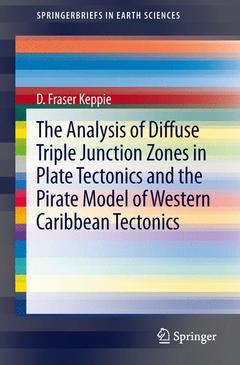Description
The Analysis of Diffuse Triple Junction Zones in Plate Tectonics and the Pirate Model of Western Caribbean Tectonics, 2014
SpringerBriefs in Earth Sciences Series
Author: Keppie D. Fraser
Language: English
Subject for The Analysis of Diffuse Triple Junction Zones in Plate...:
75 p. · 15.5x23.5 cm · Paperback
Description
/li>Contents
/li>Biography
/li>Comment
/li>
Modern researchers in plate tectonics may be concerned with the analysis of distributed deformation across diffuse plate boundaries and triple junction zones. This book extends classic methods of kinematic analysis first developed in the 1960s to the more general scenarios of diffuse deformation zones between plates. The analytic methods presented specifically target the non-rigid deformation implied by unstable triple junction configurations. These methods are then applied to the tectonic evolution of western Caribbean region which provides new ways to test and challenge the established Pacific model of Caribbean tectonics. Possible advantages of the new Pirate model of Caribbean tectonics are discussed in terms of paleo-geography and paleo-ocean connections, as well as mineral and hydrocarbon potential and seismic risks across the region.
Introduction.- Western Caribbean Tectonics.- Abstract.-Tectonic constraints.- Theoretical analysis of Western Caribbean tectonics.- Western Caribbean Plate corners.- Relative Plate motions.- Western Caribbean arc deformation style.- Review of Western Caribbean and Gulf of Mexico tectonics.- Shortening at the Eastern Caribbean Plate boundary.- Extension conjugate to Eastern Caribbean shortening.- Displacements at the Western Caribbean Plate corners.- Western Caribbean microplates.- Discussion.- Consistency with known data.- Predictive Power.- A new, multi-mode model for Western Caribbean tectonics.- The Chortis Block controversy.- Neo-Caribbean tectonics.- Meeting of the Americas.- Age of Gulf of Mexico opening.- A geodynamic model for the Western Caribbean region.- Conclusions.- References.- Normalization analysis for possibly unstable triple junction zones.- Abstract.- Introduction.- Step 1: Define a doubly-tangent, moving Euclidean tectonic reference frame.- Step 2: Determine compatibility of major plate motions and plate boundary orientations.- Step 3: Determine the stability of the normalized, hypothetical triple junction.- Step 4: Identify end-member nonrigid solutions for an unstable triple junction.- References.
These books may interest you

Tectonic Processes 37.68 €



